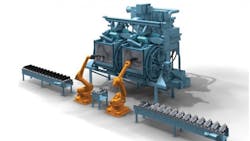High-Volume, High-Productivity Blast Cleaning for Auto Parts
For manufacturers of precision parts, producing higher volumes is an opportunity for higher revenue – but only if the additional production cost-per-part is tolerable. That is the secret to “productivity.” Bharat Forge CDP, Ennerpetal, Germany, forges steel for automotive (chassis and powertrain structures), non-automotive, railway, and heavy machinery components, and its second installation of a Wheelabrator automated blast cleaning system has been a critical factor in doubling its output of automotive crankshafts.
Wheelabrator DV Series surface cleaning systems work with manipulators to handle parts in different shapes and sizes, with no need for re-tooling as part designs change, which in addition to the systems’ high process capacity and surface cleaning performance underscores the potential for high productivity. Effective applications include blast cleaning, descaling, and shot peening for crankshafts, as at Bharat Forge CDP, as well as gear housings, cylinder blocks and heads, intake manifolds, or other high-volume part production programs.
The Series is comprised of six modular machine designs, offering options for plants according to throughput, floor space, and material handling arrangements. Manipulator shot blast systems can be combined with air-blast stations, for integration with automatic fettling lines. These systems are fitted either with rotating support shafts or flexible manipulator grippers, to pick up workpieces and transport them through the blasting process.
A robot, or other loading device secures the workpieces to be cleaned on support shafts or in the manipulator. Fully automatic shot blast systems can be equipped with sensors for part identification and workpiece-specific control of the blast parameters (blast time, shot quantity, throwing speed, workpiece movement during blasting, number of activated blast wheels, shot removal time, etc.) Selective placement of workpieces ensures optimal and continuous exposure to the blast stream, while delivering the best shot-energy efficiency and minimal wear of machine parts.
The manipulator motion can be programmed (rotating, swinging, stopping) for targeted cleaning of critical surfaces or internal passages. Spent shot is removed during the operating cycle, with no abrasive discharged with the cleaned parts.
Workpieces of different shapes, each piece weighing up to 1,500 lbs./700 kg, can be processed at rates of up to 40 mt of parts per hour.
The first Wheelabrator DV-4 machine was implemented at Bharat Forge CDP eight years ago, and in July 2015 a second, nearly identical unit was installed next to it. Now, each system has an annual treatment capacity of 1.2 million crankshafts.
A forging novelty
Due to a multiple-chamber design, DV-4 machines allow loading and unloading during the blast cycle, minimizing downtime. Though the automated process is somewhat novel for the forging industry, the high-throughput concept is in line with other initiatives in automotive parts production, thanks to short cycle times (average, 18 seconds), a high degree of process control and high level of automation.
“The slightly unusual aspect of this project was that, in anticipation of future increases in production, Bharat Forge CDP had asked us to plan for the second machine back in 2008, when we were designing the first one,” recalled Wolfgang Försterling, technical sales director at Wheelabrator. “When the second line was due (in 2015), its specification had been decided. However, we were able to use latest technologies and make a couple of improvements, based on discoveries from the first machine and its years in operation.”
Those improvements have reduced maintenance requirements and operating cost of the new machine significantly, according to the developer. Direct-drive blast wheels, frequency inverters, and MagnaValve (media flow control) technology reduce the number of movable parts, thus reducing wear. Also, optimized wear plates last longer, and direct-drive blast wheels save energy.
Those improvements also could be applied to the first DV-4 as part of strategic equipment modernization.
Each of the two barrels that form the blast chamber of the new machine were designed as two segments, which simplified transport and installation by reducing the weight and size of individual machine elements. The machine is set up flush with floor level, rather than requiring a more permanent foundation.
“This partnership (with Wheelabrator) has always worked for us, but it’s really paid off on this project, allowing us to plan for the long-term but act quickly when we needed to,” according to Rüdiger Muylkens, plant manager at Bharat Forge CDP. “The commissioning of the line went smoothly, exactly according to time plan, and without impacting on production. The fact that we were building on the concept of the first line took a lot of risk out of the equation, and delivered a machine that is perfectly tailored to our production environment.”
About the Author
Robert Brooks
Editor/Content Director - Endeavor Business Media
Robert Brooks has been a business-to-business reporter, writer, editor, and columnist for more than 20 years, specializing in the primary metal and basic manufacturing industries. His work has covered a wide range of topics including process technology, resource development, material selection, product design, workforce development, and industrial market strategies, among others.
Currently, he specializes in subjects related to metal component and product design, development, and manufacturing—including castings, forgings, machined parts, and fabrications.
Brooks is a graduate of Kenyon College (B.A. English, Political Science) and Emory University (M.A. English.)

